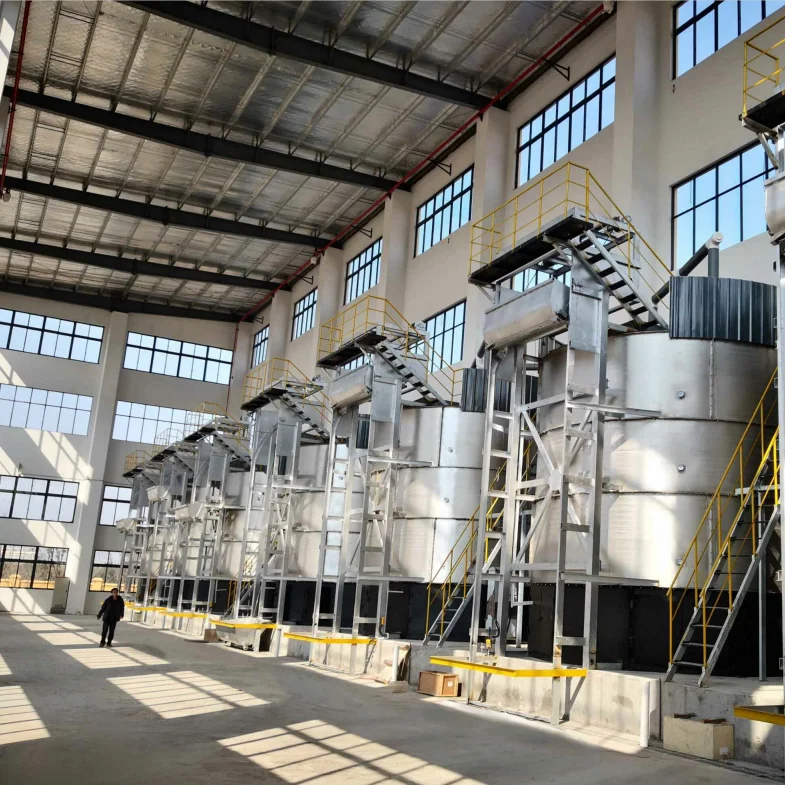High Temperature Fermentation Tanks - Summary Benefits
High temperature aerobic and anaerobic fermentation tanks SaveSave (d) Are High Temperature Aerobic And Anaerobic Fermentation Tanks Your Solution to turning waste into Resource? These tanks are also usable for secure and down-to-earth transformation of organic materials to a superior grade resources. Here we meet high temperature aerobic and anaerobic fermentation tanks pros, applications as well as premium quality.
Advantages:
1. Agricultural Wastewater High Temperature Aerobic Fermentation Tank
Aerobic fermentation tanks are thermophilic and completely aerobic, the decomposition of organic matter in a short period. At this temperature (70-80deg C) these tanks can kill off a lot of harmful bacterial and paracitic organisms. Also, they produce a top-of-the-line compost - ideal for use as an all-purpose soil amendment or plant food. Moreover, they are less bulky than anaerobic fermentation tanks.
Anaerobic Fermentation Tank:
In comparison, the anaerobic fermentation tanks are producing biogas (mainly methane) so popular as an important gaseous fuel. These tanks are capable of handling a wider range of materials than the high temperature aerobic fermentation tanks and they have also been shown to contribute in reductions greenhouse gas emissions. They also release a nutrient-rich fertilizing liquid.
Innovation:
While fermentation tanks have been in use all these years the high temperature aerobic and anaerobic fermenters are new to this art. The high temperature aerobic fermentation tank was developed in the 1970s as a new method of composting organic waste. Anaerobic fermentation tanks have been available for several decades-originally intended to make biogas from organic materials, technological developments have increased the efficiency with which these can be used.
Safety:
As long as the normal operation, high temperature of pelsert aerobic fermentation tanks and anaerobic-fermentation tank is safe. But be careful - these tanks release high temperature due to aerobic fermentation and are a source of danger. Tank will fire or even explode if it is not protected properly, as the internals can only withstand temperatures up there My Instagram Similarly, toxic gases such as hydrogen sulfide can be produced by the anaerobic fermentation tanks in which case you should provide adequate ventilation. No matter the form of fermentation, it is imperative to adhere strictly with safety guidelines and regulations when working on a fermentation tank.
Use:
High-Temperature Aerobic Fermentation Tank:
Therefore, for a aerobic condensate collection bin is combiniert with an input of organic waste and stadialisers as wood chips or straw added to high temperatures. Enabling aeration in tank is performed to manage the temperature level and maintain average oxygen content of it. Expect in 3-4 weeks you should have finished compost.
Anaerobic Fermentation Tank:
In that case, the anaerobic fermentation tank combines organic waste with water and a bacteria culture in-tank. The tank is airtight, so no oxygen can penetrate the system and biogas is collected on one side. Depending on the material, processing times can be weeks to months.
Maintenance:
The use of both aerobic and anaerobic fermenters at high temperature often necessitates routine maintenance to keep the work processes as well-maintained. Such as Temperature and oxygen level checkCleaning the tankRemoving compost or biogas antis energie. For this, there are many companies that provide the service of maintenance and repairs to fermenters.
Quality:
Considering the end products of aerobic and anaerobic fermentation tanks are directly related to processing materials, it is a relatively large proportion as well if you take into account that maintenance on these types can be so influential! Less of the compost in general can be utilised for gardening or farming. The quality of biogas produced in anaerobic fermentation tanks, on the other hand, can depend heavily upon material characteristics and habitual maintenance.
Application:
High Temperature and Aerobic - Small Scale Fermentation Tanks Urban or Suburban sites should consider high temperature aerobic fermentation tanks that are more effective for processing lower volumes of organic waste. Anaerobic fermentation tanks: Often used by homeowners, small scale farmers and community gardens are more suitable for large scale operations (e.g., dairy farms or wastewater treatment plants.
Conclusion:
Overall, hot aerobic and anaerobic fermentation tanks is a new mode of organic waste treatment which means safe production. With each of the three types of tanks, some have unique strengths and weaknesses that are specific to them as a tank in general which mostly only amounts to personal preference or required circumstance. With respect to appropriate application and operation of the organic waste feed stock, both high temperature aerobic fermentation tanks are capable of converting uncontaminated commercial food wastes into compost or biogas for nearly any end use with no engineered process interventions.
 EN
EN
 AR
AR
 BG
BG
 HR
HR
 CS
CS
 DA
DA
 NL
NL
 FI
FI
 FR
FR
 DE
DE
 EL
EL
 HI
HI
 IT
IT
 JA
JA
 KO
KO
 NO
NO
 PL
PL
 PT
PT
 RO
RO
 RU
RU
 ES
ES
 SV
SV
 TL
TL
 IW
IW
 ID
ID
 UK
UK
 VI
VI
 HU
HU
 TH
TH
 TR
TR
 AF
AF
 GA
GA
 BE
BE
 BN
BN
 KM
KM
 LO
LO
 LA
LA
 MN
MN
 MY
MY
 HAW
HAW


